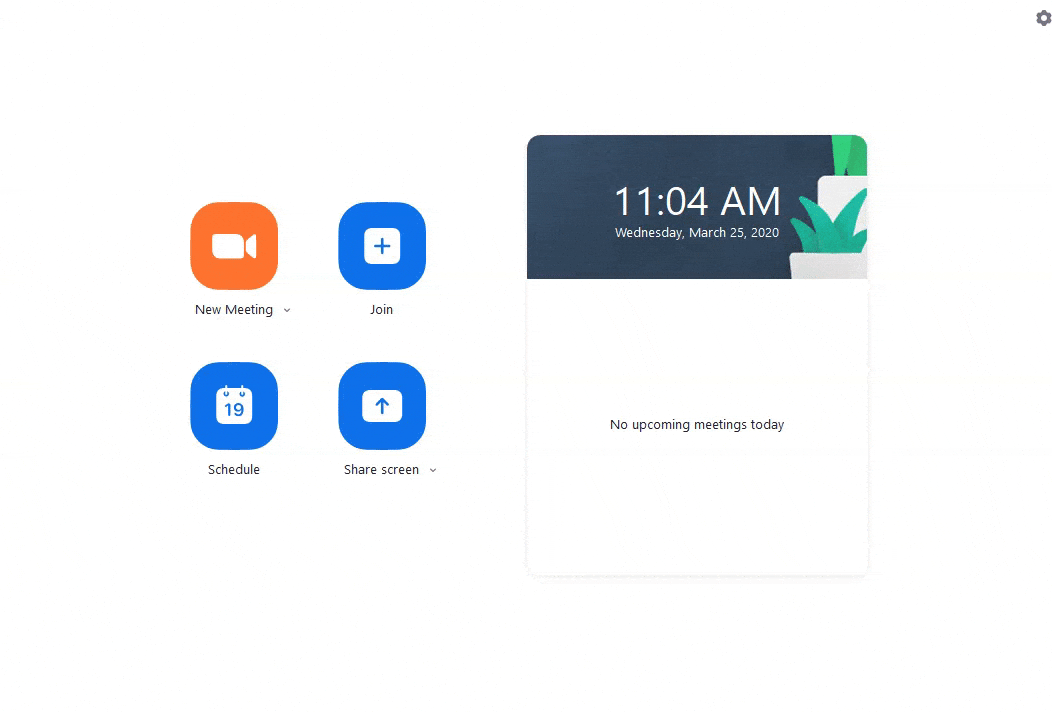What You Need To Start Using Zoom
With either a phone, tablet, desktop or laptop computer, you can be up and running on Zoom within minutes. The beauty of the platform is that it works on every device, and once the Zoom app is installed, joining or starting a meeting is as simple as sharing a Zoom link.
How To Set Up A Zoom Meeting
When you open the Zoom app, you’re presented with the option of starting a new meeting, joining an existing meeting, or scheduling a meeting.
To start a new meeting:
- Click ‘New Meeting’ on the Zoom app homepage
- Invite participants by sharing your invitation URL by email, text, or by inviting a contact from within the Zoom app

How to join an existing meeting
- Click ‘Join’ on the Zoom app homepage
- Enter the meeting ID from within the Zoom app

OR
Click the Zoom link that came with your meeting invitation to be automatically added to the meeting
To schedule a meeting:
- Click ‘Schedule’ on the Zoom app homepage
- Enter meeting details and press ‘Done’
- Send out invitations to guests using your preferred calendar app (they will receive a link with one-click access to join your meeting)
Zoom Social Protocol
Zoom meetings should be scheduled just like regular meetings. If your company normally gives a few days of notice before physical meetings, do the same for Zoom calls. It can be a distraction to some workers when Zoom meeting requests are sent for immediate meetings.
Luckily, sending a Zoom meeting request couldn’t be simpler. Zoom integrates with all of the most popular scheduling, calendar, and chat applications like Slack, Gmail, Microsoft Teams, Outlook, iCalendar and more.
Types of Zoom Calls
Zoom calls are typically conducted in one of three modes:
- Video mode
- Screenshare mode
- Audio-only mode
Each mode serves a different purpose and every participant can choose their preferred mode, but when conducting meetings, it’s helpful to let participants know what to expect beforehand.
Video Mode
Zoom’s video mode mimics the face-to-face interaction of live meetings, and gives participants more context, facial cues, and makes meetings feel more personal.
But they can also be perceived as intrusive, especially when meeting participants are not notified beforehand. Remote workers aren’t always working from locations that are ideal for video calls. Remind participants if you expect their cameras to be turned on during the meeting.
Before a video call, take some time to clean up your surrounding area, move to a well-lit space, and put on clothes that fit with your company meeting guidelines.
Videos lose their effectiveness when participants are in dark spaces, holding their phone at odd angles, with too much background noise. Be prepared.
One trick to clean up your video frame is to upload a background image for Zoom to overlay behind you. Zoom makes it easy for anyone to add a background image of choice to eliminate distractions.
One more thing to always remember while on a video call: your camera is on.
If you need to eat lunch or distract yourself during a call, turn your camera off and double-check that it’s off. Don’t be the person who leaves your Zoom camera on while going to the bathroom.
Screenshare mode
Screensharing is the killer feature that makes Zoom calls so much more information-dense than other video calling apps like FaceTime.
Meeting participants can share and annotate screens in real-time for all guests to see, making it a great way to collaborate and get feedback on documents in a group setting.
Once again, just remember that if you’re sharing your screen, every participant can see what’s on your screen. If you decide to browse the internet or open up an embarrassing document during a meeting, turn off screensharing beforehand and double-check that it’s off.
Audio-only mode
Audio-only mode is great for meetings and discussions that don’t involve visual cues. In audio-only mode, participants don’t have to worry about their appearance or sharing the screen of their device.
But remember to turn off any loud appliances or sounds that could be distracting, just like you would for a phone call.
What Zoom Calls Are For
Zoom is an excellent tool for simulating meetings that would otherwise take place in an office. Whether it’s a 1-on-1 conversation, a group feedback session, or an all-hands meeting, any scheduled get-together is easy to replicate on Zoom.
But scheduled meetings only represent a fraction of all office communication. How about all the serendipitous hallway encounters, cubicle gatherings, or spur-of-the-moment ideas?
How can remote-working companies keep those communication lines open as well?
By using Yac.
What Is Yac For
Yac is an asynchronous audio platform that offers all the features of Zoom video calls without the time constraints of scheduling a meeting time that works for everyone.

Employees using Yac can send annotated screenshares, videos, and audio messages instantly, and the recipient or group can respond whenever they want. No more scheduling conflicts, no more friction. Just say what’s on your mind, and send it off.
And since Yac’s voice messages don’t disappear, it enables remote-first meetings that keep team members up to date, without compromising anyone’s work schedule.
To start using Yac today with your remote team, click here.



